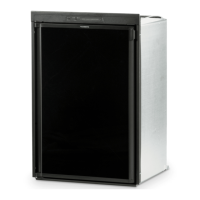10
SECTION 3 AC COMPONENTS
Heating Element
The heating element is designed to deliver a predeter-
mined amount of heat to the cooling unit. To check a heat-
ing element, remove the heater leads from the printed
circuit board and measure for proper resistance across
the two leads with a properly calibrated ohm meter. This
check is to be done with the heating element at room
temperature. You should obtain the following readings ±
10%:
Model WATTS OHMS AMPS
RM2351-4 175 80 1.5
RM2451-4 175 80 1.5
RM2551-4 175 80 1.5
RM2652 325 44 2.7
RM2662-3 325 44 2.7
RM2852 325 44 2.7
RM2862 325 44 2.7
Never over or under size the AC heater.
The refrigerator will not switch to another mode of opera-
tion until all AC power is lost. The refrigerator is equipped
with a three-prong (grounded) plug for protection against
shock hazards, and should be plugged directly into a
properly grounded three-prong receptacle.
SECTION 4 DC VOLTAGE
DC Voltage Requirements
Clean Direct Current (DC) power is mandatory for high-
tech circuits to operate as designed. A battery will provide
straight line DC power. The converter and alternator pro-
duce DC power by a series of diodes that rectify alternat-
ing current to DC. The Dometic control system will only
tolerate up to 6 AC volts on the DC line. AC ripple can be
measured by a digital voltmeter set on the AC scale at the
main DC terminal block connections at the refer. Six volts
AC or less is acceptable. If AC volts exceed 6 on the DC
incoming line the power source should be cleaned up. AC
voltage in excess of 6 volts will affect the processor and
create erratic operation. When testing for AC ripple on the
DC line put a load on the converter. The operational range
of the unit is a minimum of 9.6V DC to a maximum of
22V DC. The unit will automatically shut down until volt-
age has decreased to 18V DC. The refrigerator requires
at least 9.6V DC for proper operation; however the panel
lights will continue to illuminate until voltage has dropped
to 4V DC or below. Do not use the body or chassis of
the RV as a substitute for either of the two conductors.
The refrigerator must be connected to the battery circuit
with two wires of adequate capacity to avoid voltage drop.
Proper polarity is crucial for refrigerator operation.
No other electrical equipment or lighting should be
connected to the refrigerator circuit. Just because you
can read volts does not mean you have the amps to oper-
ate the control system. If relays buzz, lights go dim or out
during operation, this could indicate there is a loose con-
nection somewhere.
Grounds
The operation of the Dometic refrigerator is also depen-
dent on good, clean ground connections. Loose or corrod-
ed ground terminals create an unknown resistance factor
that can affect the voltage detected by the Power Module.
A loose negative DC wire will create a negative millivolt
signal that the control board will pick up and create erratic
operation. Check the integrity of the grounds from the re-
frigerator all the way to the power source/battery. Clean or
tighten any suspicious looking connections.
Note: The DC terminal block below the control board
should be cleaned and tightened at the 4 wires.
Main Terminal Block

